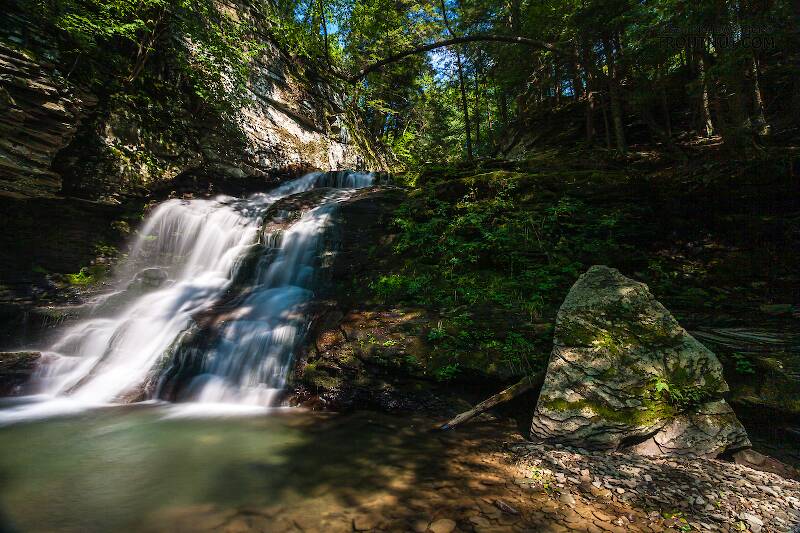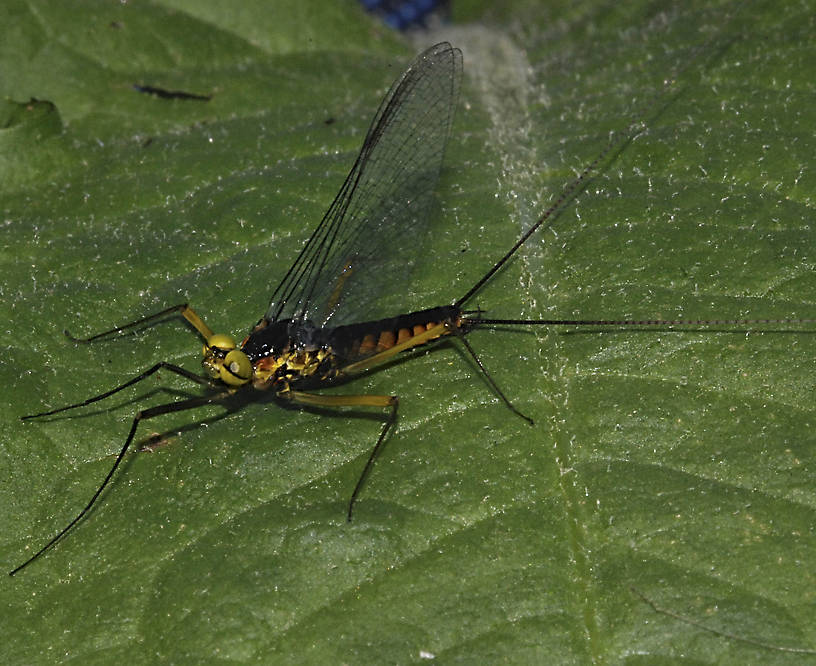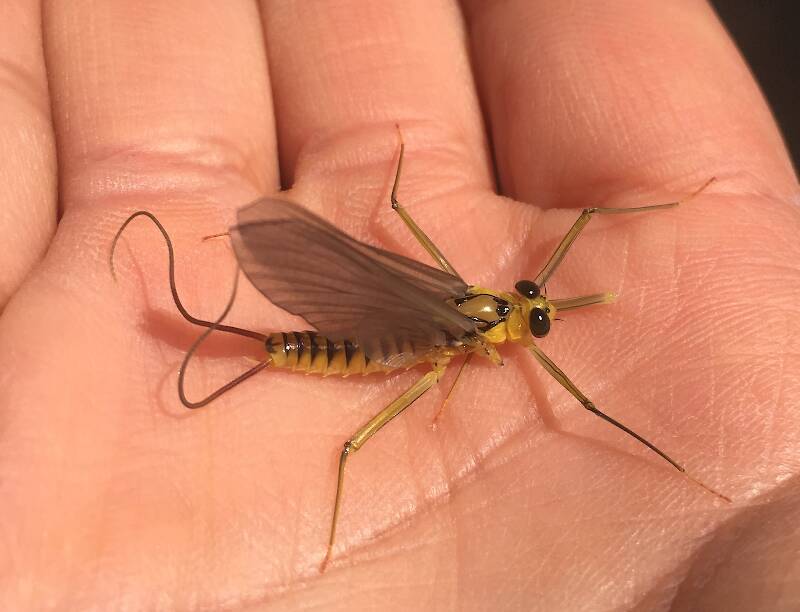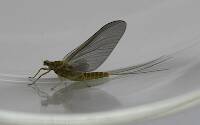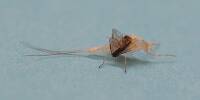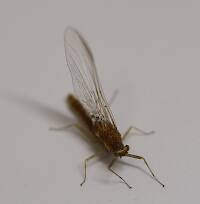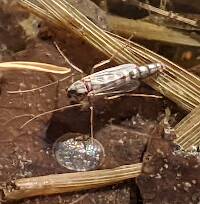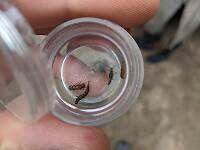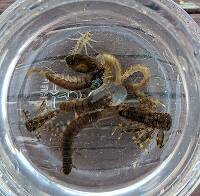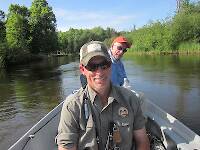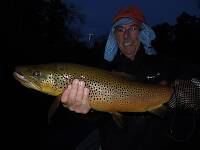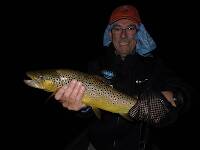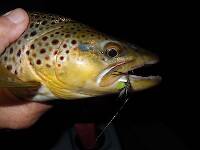
Blue-winged Olives
Baetis
Tiny Baetis mayflies are perhaps the most commonly encountered and imitated by anglers on all American trout streams due to their great abundance, widespread distribution, and trout-friendly emergence habits.
Featured on the forum

This specimen appears to be of the same species as this one collected in the same spot two months earlier. The identification of both is tentative. This one suffered some physical damage before being photographed, too, so the colors aren't totally natural. I was mostly photographing it to test out some new camera setting idea, which worked really well for a couple of closeups.

Troutnut is a project started in 2003 by salmonid ecologist Jason "Troutnut" Neuswanger to help anglers and
fly tyers unabashedly embrace the entomological side of the sport. Learn more about Troutnut or
support the project for an enhanced experience here.
This topic is about the Mayfly Species Heptagenia culacantha
This species is not known to be important to anglers. It is noteworthy for its relatively recent discovery, its large size, and the striking coloration of its nymphs and duns. They are sometimes called Tiger Mayflies.This is the largest species of Heptagenia on the continent, and it's also one of the largest in the entire Heptageniidae family. Nymphs and adult females have been collected with bodies up to a size of 19.5mm, a little over 3/4" long.
Example specimens
GONZO on Oct 19, 2006October 19th, 2006, 4:25 pm EDT
This is a shot in the dark, but I'm trying to track down descriptive information about a rather rare "mystery mayfly." Heptagenia culacantha was identified in 1985 (Evans, Botts, & Flowers). About all I have right now is a tease from the Journal of the New York Entomological Society--"This infrequently taken species, one of the largest and most striking North American heptageniids, is known only from Pennsylvania and New York."
The reason I'm so interested is that I believe I encounter a fishable hatch of these mayflies every season on one of my favorite PA brook trout headwaters. If that conjures a picture of fishing to 6-7" dinks, you'll need to double those numbers to appreciate how special this stream really is. Add to that an image of the fish rising to these beautiful "mystery mayflies" that hatch in the evening, following a day-long emergence of Dark Green Drakes (Litobrancha recurvata)!
It is such a special event that it is one of the very few things that can pull me away from fishing my favorite Olive Morning Dun hatch (Drunella lata, nee cornuta). Help!
The reason I'm so interested is that I believe I encounter a fishable hatch of these mayflies every season on one of my favorite PA brook trout headwaters. If that conjures a picture of fishing to 6-7" dinks, you'll need to double those numbers to appreciate how special this stream really is. Add to that an image of the fish rising to these beautiful "mystery mayflies" that hatch in the evening, following a day-long emergence of Dark Green Drakes (Litobrancha recurvata)!
It is such a special event that it is one of the very few things that can pull me away from fishing my favorite Olive Morning Dun hatch (Drunella lata, nee cornuta). Help!
Troutnut on Oct 19, 2006October 19th, 2006, 6:11 pm EDT
I've seen a picture. A dun from the Delaware was photographed and posted on the Fly Fisherman forum for an ID contest. It was posted (and maybe taken? I forget) by a guy who works at one of the fly shops downtown in Hancock, NY. I have his business card somewhere, and I'll see if I can find it and email him for the picture.
I remember that the dun was large and unusually "pudgy" for a Heptagenia mayfly, and it was a striking yellow color. Beyond that I can't remember.
Here's the citation for the paper in which the discovery of this species was announced: Evans, J.L., Botts, W.F. Jr. and R.W. Flowers. 1985. A new Heptagenia (Ephemeroptera: Heptageniidae) from the Susquehanna and Delaware Rivers from eastern North America. Annals of the Entomological Society of America 78: 5-7.
I don't have it yet, but it's near the top of my to-get list. I know it's in the Cornell entomology library, so I'll photocopy it next time I'm there.
I remember that the dun was large and unusually "pudgy" for a Heptagenia mayfly, and it was a striking yellow color. Beyond that I can't remember.
Here's the citation for the paper in which the discovery of this species was announced: Evans, J.L., Botts, W.F. Jr. and R.W. Flowers. 1985. A new Heptagenia (Ephemeroptera: Heptageniidae) from the Susquehanna and Delaware Rivers from eastern North America. Annals of the Entomological Society of America 78: 5-7.
I don't have it yet, but it's near the top of my to-get list. I know it's in the Cornell entomology library, so I'll photocopy it next time I'm there.
Jason Neuswanger, Ph.D.
Troutnut and salmonid ecologist
Troutnut and salmonid ecologist
GONZO on Oct 19, 2006October 19th, 2006, 6:27 pm EDT
Thanks Jason! Your recollection of a large fly with a "striking yellow color" helps.
P.S.--If you could manage to locate the 1984 O. S. Flint paper on Brachycentrus when you're at Cornell, that would be awesome! I have some questions about B. solomoni.
P.S.--If you could manage to locate the 1984 O. S. Flint paper on Brachycentrus when you're at Cornell, that would be awesome! I have some questions about B. solomoni.
Softhackle on Oct 20, 2006October 20th, 2006, 1:55 pm EDT
Gonz,
NatureServe Link
Fly Fisherman Magazine Forum Link
These are a few places to look. As Jason has said the second is the Fly Fisherman Mag site, but it's got a couple photos.
I'd get in touch with someone in your area in your fish and wildlife service that might be able to assist you in getting more info on this species, and if in fact, it is what you think it is. Good luck in your quest, and keep us posted on your progress.
Mark
NatureServe Link
Fly Fisherman Magazine Forum Link
These are a few places to look. As Jason has said the second is the Fly Fisherman Mag site, but it's got a couple photos.
I'd get in touch with someone in your area in your fish and wildlife service that might be able to assist you in getting more info on this species, and if in fact, it is what you think it is. Good luck in your quest, and keep us posted on your progress.
Mark
"I have the highest respect for the skilled wet-fly fisherman, as he has mastered an art of very great difficulty." Edward R. Hewitt
Flymphs, Soft-hackles and Spiders: http://www.troutnut.com/libstudio/FS&S/index.html
Flymphs, Soft-hackles and Spiders: http://www.troutnut.com/libstudio/FS&S/index.html
Troutnut on Oct 20, 2006October 20th, 2006, 2:41 pm EDT
Thanks SoftHackle.
The links were stretching the forum (my text-parsing code is not without its flaws) so I edited to make them shorter, live links.
In response to this discussion I've added H. culacantha to the live part of the site and reposted the photo link in a topic there. I'll be interested to see if that's the fishable hatch Gonzo found or not.
I wouldn't be too optimistic about state natural resource agencies being helpful on mayfly species IDs. They mainly use invertebrates for biomonitoring and that rarely requires identification beyond the genus level. Reliable species IDs for obscure species are much harder and require a whole library of papers or an experienced entomologist. You're more likely to have luck with a local university's biology or entomology department, I would think.
Of course, the guys who do invertebrate sampling for the state are more likely than most to be fly fishermen and bug hobbyists, in which case they might know more than their job requires. Maybe you'd luck out.
The links were stretching the forum (my text-parsing code is not without its flaws) so I edited to make them shorter, live links.
In response to this discussion I've added H. culacantha to the live part of the site and reposted the photo link in a topic there. I'll be interested to see if that's the fishable hatch Gonzo found or not.
I wouldn't be too optimistic about state natural resource agencies being helpful on mayfly species IDs. They mainly use invertebrates for biomonitoring and that rarely requires identification beyond the genus level. Reliable species IDs for obscure species are much harder and require a whole library of papers or an experienced entomologist. You're more likely to have luck with a local university's biology or entomology department, I would think.
Of course, the guys who do invertebrate sampling for the state are more likely than most to be fly fishermen and bug hobbyists, in which case they might know more than their job requires. Maybe you'd luck out.
Jason Neuswanger, Ph.D.
Troutnut and salmonid ecologist
Troutnut and salmonid ecologist
GONZO on Oct 21, 2006October 21st, 2006, 5:33 am EDT
Jason and Mark, many thanks for your help! The photos were all I needed. I'll be on the lookout for this spectacular mayfly. From the size, color, and markings, it is certainly one I will recognize on sight. It is definitely not the species in question, however. :(
My mystery mayfly is unquestionably a member of the Heptageniidae, but I think I will have to return to my previous search of Maccaffertium/Stenacron species for an answer. Initially, I assumed it was a large and unusually bright version of S. interpunctatum, but I have only played catch-and-release with a few specimens in the field. Next year, I'll have to keep a few in order to be certain.
Until then, the quest goes on. Thanks aqain.
My mystery mayfly is unquestionably a member of the Heptageniidae, but I think I will have to return to my previous search of Maccaffertium/Stenacron species for an answer. Initially, I assumed it was a large and unusually bright version of S. interpunctatum, but I have only played catch-and-release with a few specimens in the field. Next year, I'll have to keep a few in order to be certain.
Until then, the quest goes on. Thanks aqain.
Boyle on Apr 17, 2007April 17th, 2007, 4:56 pm EDT
The first time I ever heard of the mayfly now known as Heptegenia culacantha came years ago, probably in the late 1970s or very early 80s,when Paul Schmookler, who collected aquatic insects professionally, showed me a color photograph of an unusually large and patterned nymph that he had discovered in the Delaware River and called the "tiger mayfly." Scientific protocol, so I understand, holds that a new species pf insect can only be named and described as an adult, not as a nymph. Given Paul's zealous explorations, I am quite certain that he was the first person ever to encounter Heptagenia culacantha.
Troutnut on Apr 17, 2007April 17th, 2007, 5:43 pm EDT
Neat, Boyle. Thanks for the background. I would love to collect one of these nymphs, but I'm sure it would take a lot of luck.
Jason Neuswanger, Ph.D.
Troutnut and salmonid ecologist
Troutnut and salmonid ecologist
Konchu on Apr 18, 2007April 18th, 2007, 12:37 am EDT
Often new species (sometimes even genera and families) of mayflies or other inverts are described based on only a single stage; however, many taxonomists are reluctant to do so unless they have at least a larva and male adult (in the case of mayflies). Sometimes this is practical; other times it is not. Ex: species is from NY & PA - practical. Species is from a remote part of a certain hot country with a lot of sand - not practical.
Thanks for some of the inside story on H. culacantha, Boyle.
Thanks for some of the inside story on H. culacantha, Boyle.
Quick Reply
Related Discussions
Topic
Replies
Last Reply
4
Apr 12, 2014
by Brookyman
by Brookyman
1
Aug 21, 2007
by Gene
by Gene
0
Jul 17, 2019
by Troutnut
by Troutnut
2
Apr 20, 2020
by DangerAF1
by DangerAF1
26
Jul 17, 2014
by Gus
by Gus

